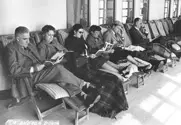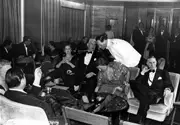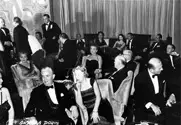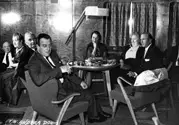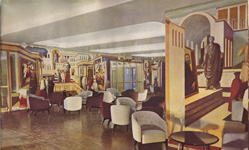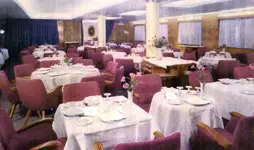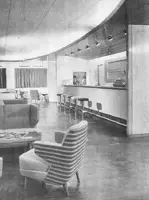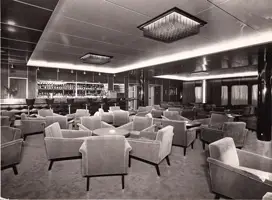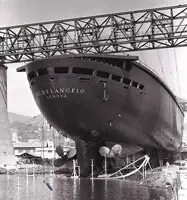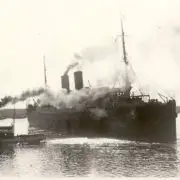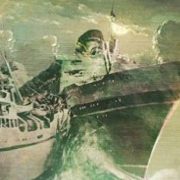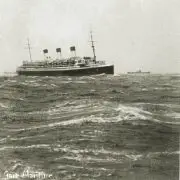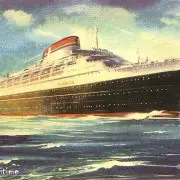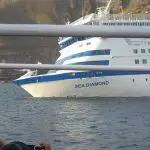New books celebrate Italian Ocean Liners
In a world increasingly glutted with coffee-table format books, filled with minimal quantities of large-sized text and awash in “rare photographs and memorabilia” that are neither rare nor well-reproduced, it was refreshing to simultaneously receive two volumes to which the term “book of the decade” can be applied. Elegant, impeccably laid out, aimed at literate adults, these works are the perfect memorial to Italy’s three great, doomed, postwar flagships. Cento Uno Viaggi and La Fine di Una Epoca belong in every liner buff’s home library, and should serve as a template for future authors who wish to create books of both style and substance.
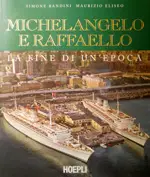
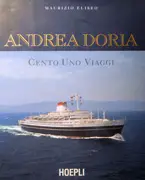
Getting past the bad news first, the texts are in Italian, with no English, French, German, or Spanish translation provided. The question arises, when ordering books in written in an unfamiliar language, “Is it worth paying a rather high import price for a book I cannot read?” The answer, in most cases, would be “No. There is no way of justifying paying $70-$90 for a coffee table volume I cannot read.” Potential buyers of these Italian-language works, however, can be assured that they will consider the money well spent. These are anti-coffee table books; beautiful to look at, but substantial to read. The photo selection and reproduction is infinitely superior to most of the competition, and justify the cover price for those unable to read the text.
If You Can Read Italian
Both volumes are straightforward chronologies, from conception to destruction and afterlife. Eliseo, and Eliseo and Bandini, write in a style that translates well. They manage to be enthusiastic without going over-the-top into florid, and can relate technical details in a way that makes them interesting to a non-techie.
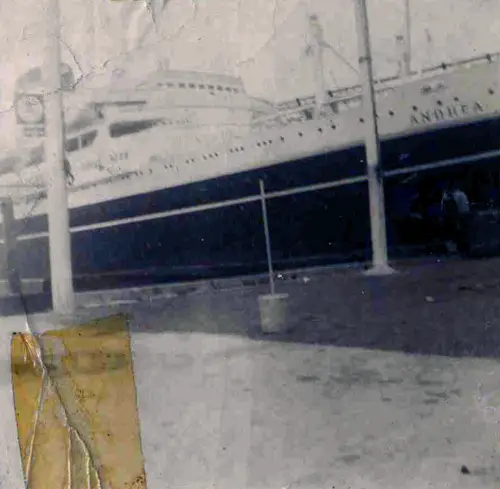
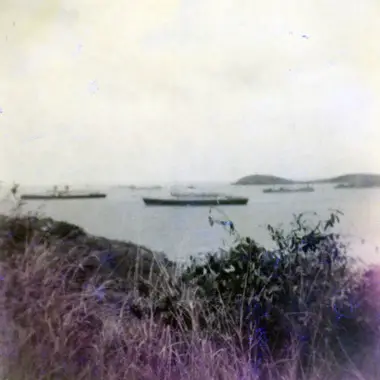
Left: Andrea Doria in 1956 (Jim Kalafus Collection), Right: Andrea Doria at St Thomas (Michael Poirier Collection)
The Andrea Doria book does not short-change the one hundred voyages she completed, in order to devote the lion’s share of the page-count to the disaster. Décor, life on board for passengers and crew, service incidents, are given just the right amount of attention, and allow the reader a better context into which to put the 1956 disaster. Chapters-within-chapters (for instance, a one-page essay about artist Salvatore Fiume’s mural La Leggenda d’Italia) are attractively presented on dark backgrounds that set them apart from the main text. A minor complaint is that the deck plan reproduced in the book has occupancy numbers but not cabin numbers.
Passengers relaxing and partying aboard the Andrea Doria
(Michael Poirier Collection)
The Michelangelo and Raffaello volume relates the story of two great liners that emerged on the scene slightly too late, had brief but very glamorous lives, and then met obscure ends, without lapsing into the trite. The stories of these lovely, fun, ships are ultimately very sad, and the text imparts a sense of wasted potential upon the reader without becoming loopy and elegiac. The life on board sections are a pleasure. The ships were never headline-grabbers in the U.S.A. or U.K. (by the time they emerged, in 1965, NO ships were, other than when they debuted, encountered misfortune, or retired from service) and so, for many readers, this will be their first introduction to the service lives of the Michelangelo and Raffaello.
Cross section of the Michelangelo and Raffaello
If You Can’t Read Italian
Both books are as heavily illustrated as a coffee table volume. I can promise that even the most jaded liner buff will NOT quickly flip thru the pages thinking “I’ve seen that one. And that one. And that one….”
The Andrea Doria market, in particular, has been glutted with books containing interchangeable photo sections. The Italia archive, and private collections, have been combed for photos you haven’t seen before, and they are presented in cuttingly sharp focus on high-quality paper. The majority have from-the-negative crispness. A great deal of thought obviously went into presenting the images. The twin glitches which plague so many liner books ( “I wish they presented that photo in larger format” and “Why did they devote ¾ of a page to that mediocre image?”) have been avoided. Photos that should be large are large. Photos that are best presented at quarter page or eighth page size, are. The layout avoids the annoying scrapbook look of recent years, in favor of elegant horizontal and vertically arranged blocks of photos and text. Interesting photos are not ruined by having bits of memorabilia photo-shopped over them to suggest a scrapbook. Pictures are not whimsically arrayed, so one does not have to turn the book to look at them.
Lack of padding is, perhaps, the best aspect of the books’ illustration. There are no irrelevant, or only marginally-related, images. Each photo advances the story. The balance between interior shots and exterior shots, between techie photos and glamour photos, and between posed celebrity shots and unposed, non-celebrity, images is just right. Worthy of praise, as well, is that the photos appear in close proximity to the portions of the text pertaining to them. One does not have to flip back and forth repeatedly, trying to match text to photo or vice-versa.
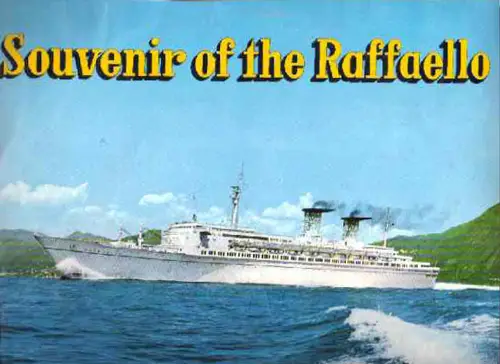
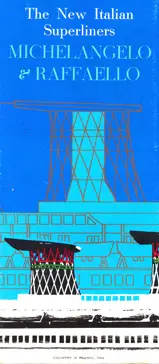
The Michelangelo and Raffaello have been ill-served in the past, as far as photo availability is concerned, and most buffs will draw a blank when it comes to their high-style interiors. The Andrea Doria is somewhat more familiar, but the same five interior shots have been used to the point of exhaustion, and only the first class lounge mural, and Zodiac Suite can be described as well known. These books contain excellent, first generation print- quality views of all the major, and many of the minor, public spaces, and cabins. The Michelangelo and Raffaello each had radically different interior décor from the other, and one of the book’s fun aspects is comparing photos and playing the “Which ship did it better?” game. The Andrea Doria’s interiors were as lavish as 1950s modern could be, and readers will enjoy seeing the furniture, fittings, and artworks which were installed in all three classes. The Andrea Doria volume will serve as an eye-opener for those who dismissively think “Zodiac Suite” when her décor is mentioned.
Andrea Doria first class lounge, dining saloon and cabin class bar
(Jim Kalafus collection)
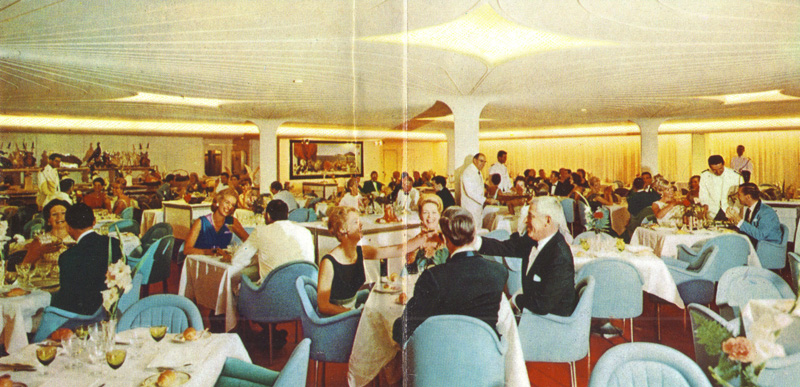

One is advised to keep Google Translate on hand. The photo captions can be typed in easily.
To answer the Doria buffs’ burning question; yes, there are good-quality views of the disaster that you probably haven’t seen, some in color, in the Andrea Doria volume. A particularly nice series of color slides, taken of the sinking ship around dawn, appear courtesy of Richard Faber. I found the chapters about the disaster fairly well balanced. There were no earth-shattering disclosures, but I did not expect that there would be. The text avoided the overpowering note of good guy/ bad guy hysteria that so frequently creeps into Andrea Doria books and discussions. It is, not surprisingly, supportive of Italia and the Doria’s crew, but makes its case well. It serves as a good foil to the spate of books that portray the disaster in simplistic black and white terms.
There is also a good selection of photos of the April 1966 incident in which the Michelangelo was struck by a large wave during a storm and her forward superstructure caved in, with fatalities. The famous photos of the wave approaching and rolling across the bow, towards the photographer, are present, and so too are unfamiliar views, including one of a devastated looking first class ballroom. The text provides the most comprehensive account of this accident to date.
Left: Raffaello Lounge, Right: Michelangelo prior to launch
(Courtesy Dan Scott, Virtual Ocean Liner Museum)
One hopes that a volume, or volumes, of equal quality, about the Cristoforo Colombo (the Andrea Doria’s sister ship, which, internally, aimed for understated charm rather than cutting-edge, almost too elaborate, glamour and led a long, seemingly charmed life) and the Leonardo da Vinci (The Andrea Doria’s fatally expensive to operate replacement, whose interiors beautifully bridged the styles of the 1953/54 liners and the two 1965 flagships) will be forthcoming.
Andrea Doria: Cento Uno Viaggi, and Michelangelo e Raffaello: La Fine di Una Epoca, can both be ordered directly from Amazon Italy, or from liner book dealers in the U.S. and U.K. They are wonderful, mature, books that manage to be lavish and erudite, and are worthy of inclusion with the best.
Andrea Doria: Cento Uno Viaggi (101 Voyages)
Maurizio Eliseo
Hoepli, 2006
279 pages.
Michelangelo e Raffaello: La Fine di Una Epoca (The End of an Era)
Simone Bandini and Maurizio Eliseo
Hoepli, 2010
321 pages, plus fold out, color, deck plan and black and white profile.
Images, courtesy of the reviewer, are intended to be representative of the subject matter but not taken from the books.

